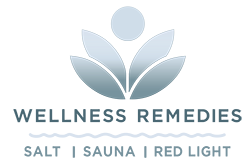Could salt, so harmful when too much is taken in through the digestive system, deliver positive health effects when inhaled?
Just imagine: A patient presents with a mucus plug so large that, even after conventional interventions, the treating physician sees no way to avoid a bronchoscopy. In an 11th-hour effort to spare the patient from the uncomfortable procedure, the doctor agrees to explore a natural approach to remove the massive buildup from the lungs. In tandem with aggressive vest vibration, the patient undergoes 6-8 dry salt therapy treatments over a period of two weeks. To the referring doctor’s welcomed surprise – and the patient’s great relief – the mucus plug miraculously clears, and the need for invasive measures is eliminated.
You don’t need to use your imagination if you’re Tami Peavy, MBA, MPT, DPT. As CEO and clinical director of La Mesa Rehab, located in the California city bearing the same name, she had a front-row seat as the above scenario unfolded in real life. Her program provided the salt treatment, known as “halotherapy,” which has been lining up fans ever since the facility first started offering the service in 2017

The therapy uses a piece of equipment known as a halogenerator, which grinds 100% pure sodium chloride into tiny microparticles and pumps the resulting dry salt aerosol into a treatment space. The patient inside the enclosure inhales it, breathing in a whistle pattern to keep the lungs open for a longer period of time on the exhale. “Each breath is very purposeful and determined,” says Peavy, describing how dry salt therapy recipients mimic an instructional video they view before their introductory session. Later, as they become accustomed to the environment and the breathing technique, those without physical limitations might even incorporate some dynamic motion – standing up and sitting down – while breathing in the salty air.
“Once it goes into the trachea and down into the lungs, it seeks out moisture [like mucus], attaches itself to it, and shrinks it,” Peavy says, explaining how dry salt helps clear airway passages. A typical protocol might entail three 10-minute sessions per week, before or after traditional pulmonary rehab, over the course of three months. Peavy’s patients have expressed a preference for pre-PR salt treatments, finding that it opens up their lungs and prepares them to better participate in their usual pulmonary therapy. Based on anecdotal evidence she’s collected from her patients, the therapy is doing wonders for people with emphysema, asthma and other respiratory issues – with some even crediting the practice for keeping them out of the hospital.
In another example, the proud AACVPR member recalls a patient who was receiving care at La Mesa Rehab for his back. Over the course of his physical therapy sessions, she learned that the man – himself a physician – was tormented by post-nasal drip that routinely and mercilessly disrupted his rest at night. Within two weeks of introducing him to dry salt therapy, however, his symptoms and quality of life improved markedly. Stunned, his wife visited the facility to thank staff for the best sleep that her husband – and she, by extension – had experienced in three years.
Outcomes like these are the norm at La Mesa Rehab, according to Peavy, who reports that her program can barely keep up with patient demand for the service. Even as the positive feedback continues to pour in for this relatively new twist on salt use for health, Leo Tonkin at the Salt Therapy Association (STA) in Boca Raton, Florida, offers a reminder that the benefits of salt have been known for quite some time.
Try It Dry
Going back centuries, STA co-founding director Tonkin notes that salt was initially valued as a preservative for meats and fish. “Nothing can grow on salt!” he declares. “Salt kills bacteria and viruses.” Implications for the medical field – where salt has long been used in saline solution to clean the eyes and maintain IV lines, among other applications – are therefore not a stretch. Not coincidentally, he points out, sodium chloride is also found in nebulizers and steroid inhalers commonly prescribed for patients with respiratory problems. That’s because while the anti-viral and anti-bacterial properties of salt help keep the lungs clean, salt also happens to be a natural anti-inflammatory. “When our esophagus, nasal cavity, bronchioles and other aspects of our lungs have inflammation, that’s what restricts air flow – which is why you need an inhaler or to be on medication,” he explains, noting that super-absorbent dry salt helps extract excess mucus, clearing out the bronchial alveoli.
Although salt has long been utilized for medical purposes in its wet or moist form, the concept of inhaling aerosolized dry salt is still coming into its own – at least in the United States. Studies as early as the 1800s, Peavy reports, showed that salt miners in Eastern Europe boasted superior lung health than the rest of the population and were less frequently affected by colds, seasonal influenza and conditions like bronchitis. Within the last half a century, though, Tonkin says Russian scientists have developed machinery to re-create the dry salt particles found in mines in countries including Poland, Belarus and Ukraine, training fresh attention on the therapy. The elevated profile and strength of research findings overseas has led some European countries to classify dry salt therapy as a medical treatment, qualify it under health insurance and adopt it as a healthcare modality.
To the contrary, U.S. research on halotherapy is scant – which Peavy and Tonkin believe has contributed to much slower uptake here. The other big denominator, they agree, is the financial burden. As a ballpark figure, Peavy estimates start-up equipment costs at about $10,000. “And of course,” she continues, “the problem, as with most holistic practices and modalities, is that it’s not covered by insurance [here].” Without reimbursement, she says, it’s difficult for some programs to justify the expense. If it were a covered item, she suspects interest would snowball quickly, because the outcomes are just that remarkable. Peavy estimates that 99.9% of her patients who experiment with dry salt therapy through pulmonary rehab not only love it, but benefit from it.
That America hasn’t caught up to Europe with respect to the practice is unfortunate, laments Peavy, who believes the combination of dry salt therapy and conventional treatment could have added 10 years to the life of her father, who passed away from complications of COPD and emphysema. Fresh modalities are especially needed right now, she suggests, considering that the nation is coming out of a pandemic and is now dealing with a spate of ‘long COVID’ cases. “Salt is like cannabis,” Peavy offers as an analogy. “Salt therapy is simple and natural; and sometimes it’s the most simple and natural approaches that are the most overlooked.”
Growing Momentum, Endless Potential
That’s not to say that dry salt therapy is unattainable in the United States, just that it isn’t the mainstay it could be. It’s not FDA-approved, it’s not covered by insurance and it’s not everywhere … but it is available, according to Tonkin, who puts the number of U.S. providers at about 2,500, including facilities billed as medical spas. “There are also pulmonologists who are referring patients to salt rooms,” he states. Anthony J. Cuomo, MD, medical director at La Mesa Rehab, is one. “In my 50 years of practice in pulmonary medicine, I have regularly used lavage with saline solution during bronchoscopy. The salt solution reduces the viscosity of sputum, liquefying it and making it easier to expel,” he says in a statement. “Similarly, inhaling a dry salt mist from a halogenerator also liquefies mucus, reducing its viscosity, and is just as effective as bronchoscopy with lavage in clearing the airway. I highly recommend it for my patients during pulmonary rehab.”
The dry salt community doesn’t end there, Tonkin elaborates. “You have an allergist who owns a salt room; you have ENTs who talk about it; pediatricians refer young patients,” he rattles off. “There are respiratory therapists who are in the business.” And yes, Tonkin shares, there are even some pulmonary rehabs, like Peavy’s, that are delivering dry salt therapy to their patients.
Importantly, he reassures that there are almost no contraindications associated with the practice. Patients who have hypertension or are following salt-restricted diets need not worry, because the amount of inhaled salt that makes its way into the bloodstream is “minimal,” by Tonkin’s estimation. The caveat, he reminds, is to always consult a physician if there are questions or concerns.
It’s also important, he continues, to patronize credible commercial providers if dry salt therapy is not accessible through a local medical facility. First and foremost, he advises that the provider must have a halogenerator and must use pure-grade sodium chloride. That rules out places peddling Himalayan salt treatments. That salt is not purified, Tonkin reveals, so while it may create a relaxing ambience, it provides nothing in the way of respiratory benefit. Additionally, he says, the environment surrounding the salt booth or room must be properly ventilated. STA has published standards for the industry so that consumers know what to look for and what to do or not do.
As a final note, Tonkin emphasizes that a respiratory condition doesn’t necessarily need to be present to warrant dry salt therapy. “Think about the quality of the air that you and I breathe, indoors and outdoors, all day,” he nudges. “Ninety percent of the world’s population, according to the World Health Organization, lives and breathes in poor air quality – our school systems, corporate buildings, antiquated HVAC systems in our homes. People need to take action to clean themselves out.” Peavy agrees that the scope of dry salt therapy goes beyond individuals with respiratory disease. At La Mesa Rehab, her staff and even some family members take advantage of the facility’s salt booth whenever they have a cough or are in the beginning stages of a respiratory infection.
Written By Denise Williams


